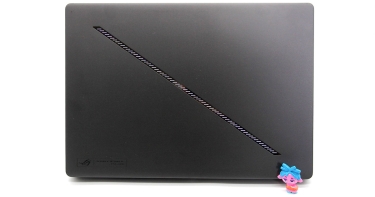Asus ROG Zephyrus G14 Specs
| Screen | 14-inch, glossy, 120Hz, 2,880 x 1,800, OLED display |
| Processor | 4-5.2GHz AMD Ryzen 9 8945HS CPU |
| Memory | 16GB LPDDR5X-6400 RAM |
| Graphics | 8GB Nvidia GeForce RTX 4060 |
| Hard drive | 1TB |
| Connectivity | Wi-Fi 6E Bluetooth 5.3 2 x USB-A 3.2 Gen 2 1 x USB-C 3.2 Gen 2 1 x USB-C 4 1 x 3.5mm audio jack 1 x microSD card reader 1 x HDMI 2.1 |
| Speakers | Quad speaker array |
| Extra Security | Windows Hello (webcam) |
| Webcam | Full HD |
| Microphones | Triple mic array |
| Battery | 73Wh |
| Dimensions | 311 x 220 x 16mm |
| Weight | 1.49KG |
| SKU | GA403UV-QS093W |
Design, Features and Ergonomics
While Asus’ Zephyrus line started off with a design that had a foot in the office and one at a gaming LAN, recent models became more and more gamer oriented. The new 2024 G14, however, has done away with all of the ostentatious lid lighting and colour schemes and replaced them with an LED-lit ‘Slash’ on a grey background. It can show-off some clever lighting effects but it looks even more corporate once the lights have been turned off. We reviewed the 16-inch model at High Performance Laptops and struggled to get over our initial disappointment, but it’s been growing on us.
The new, 14-inch model feels very premium thanks to its CNC-milled aluminum-alloy chassis. The stripe is still more interesting than any other laptop lid on the market, even if it doesn’t hit the head-turning levels that Asus helped set.
Opening it up reveals a touch-type keyboard (with ’12 per cent larger’ keys) that’s very comfortable and accurate to type and game upon for extended periods. There’s not enough room for a number pad and the arrow keys are reduced in height but at least they’re isolated and intuitive to feel for. The trackpad feels high quality and is smooth and accurate with good-feeling, well-weighted, quiet, button actuations.

The screen comes under Asus’ Nebula brand which means it should be fast, colourful and display high-quality images. We’ve not been overly impressed with some Nebula models but this OLED variant bucked the trend.
It’s a high-resolution, 2,800 x 1,800 display that shows a comfortable and crisp Windows Desktop. Being an OLED, colours are vibrant, true blacks are black and contrast is impressive. Asus has also managed to reduce the glossiness of the coating into a semi-gloss which maintains the colours and contrast while impressively reducing reflectivity to a degree. It also works with Windows HDR (despite not being a Nebula HDR display) which means more details are revealed in bright and dark areas and both colour and monochromatic transitions are rendered smoothly without stepping. On top of that, it supports 100 per cent of the difficult DCI-P3 colour space, which designers will like.

The 120Hz refresh rate and fast pixel response time keeps fast-moving objects rendered relatively smoothly but some motion blur is evident. However, while it’s far from the fastest screen, I still only see competitive shooters complaining.
The Full HD webcam (which supports Windows Hello login) does very well at capturing a sharp, grain free image, even in low light. The mic array affords very good audio capture, but make sure the fan isn’t running in background.

The four, dual-sided speakers (and their CNC-milled audio channeling) make audio excellent. The G14 provides great fidelity from top to bottom plus punchy bass that most people wouldn’t expect from a small laptop.
Connectivity
Despite the small chassis, Asus packs the ports into the G14.


Inside there’s Wi-Fi 6E and Bluetooth 5.3. It’s an impressive collection although I’d always prefer to see Wi-Fi 7 nowadays.
Ultimately, the Asus ROG Zephyrus G14 is very good to interact with.
Features, Ergonomics and Design Score: 3.9 / 5
Performance
Inside Asus’ 2024 ROG Zephyrus G14 is a 4 – 5.2GHz AMD Ryzen 9 8945HS processor with its eight cores, 16 threads and its (16 TOPS) Neural Processing Unit.
This combined with 16GB of very brisk LPDDR5X-6400 RAM, a 1TB NVMe hard drive and an Nvidia GeForce RTX 4060 GPU (with 8GB of GDDR6 RAM), to score 8,151 in the general-purpose PCMark 10 test which is impressive for any laptop, let alone one of this size. (Score: 4 / 5)
In the Cinebench processor-based rendering tests, the G14 scored 2,766 and 17,012 in the rapid R15 and longer R23 tests respectively. These aren’t the fastest scores but they’re still above average which, again, is very impressive for an ultraportable laptop. (Score: 2.7 / 5)

In the difficult, 3DMark, ray-tracing, gaming benchmarks, the Zephyrus G14 scored 6,947 (average 32.2fps) in the difficult Port Royal test and 2,815 (28.2fps) in Speed Way. These scores illustrate that the G14 can play the latest and greatest games but that you’ll likely need to drop the resolution and settings to keep everything running smoothly.
In the AAA-gaming-title-mimicking Time Spy and Fire Strike Extreme tests, the G14 scored 11,488 (average 71.1fps) and 13,061 (average 61.8fps) respectively. These scores show that it can easily play such titles.
In the much-easier 3DMark Night Raid benchmark, the Zephyrus scored 61,961 which is an average of 565fps. This underlines the G14’s ability to easily play casual and competitive games at framerates that make full use of the fast, 240Hz screen.
3D Performance Score: 3.2 / 5
Cooling and Noise
The 2024 Zephyrus G14 makes use of Asus’ ROG Intelligent Cooling technology that uses three fans, improved heat pipes (and exhaust vents) plus high-quality liquid-metal thermal ‘paste’ from Thermal Grizzly. The result is a much-cooler (running) laptop. It can still get warm underneath but more notable is that the area surrounding the keyboard can warm-up – sometimes considerably.
Under load the fans can turn into a loud whoosh – especially when forced into using the discreet Nvidia GPU. However, in Silent Mode it’s very quiet – albeit at the expense of heating up even more. It’s far from being a lap volcano like its ancestors, though.
Portability and Battery Life
Despite the hefty internals, the Zephyrus G14 weighs just 1.49KG, placing it in ultraportable territory. It’s also got a thin, reasonably small power brick which, along with the cables, add an extra 576g to the mix which is low for a high performance laptop. The CNC-milled aluminium chassis (and strong hinge) means it’s robust and ready to be lugged around on the road while the 16mm thickness makes it feel thin in your hand.

Meanwhile, the 73Wh battery ran our PCMark 10 Modern Office test for an impressive 12 hours and 24 minutes (using AMD’s integrated 780m GPU) which is more than a day out of the office. It’s very portable indeed for a powerful laptop. Portability and Battery Life Score: 3.4 / 5
Price and Value
Such combinations of power, portability and quality often come at a premium but the $3,399 price tag of the Zephyrus G14 renders it very good value. A variant with an RTX 4050 GPU costs $3,099 and one with a 4070 costs $3,699.
Price: 2.5 / 5
Value: 4.1 / 5
Overall
At the end of the day, the 2024 Asus ROG Zephyrus G14 has succeeded in being a unicorn laptop because it does very well at everything. Its propensity to get warm is its only issue but this is a relatively minor one and it’s a significant improvement on its predecessors. What’s best is that it comes at a price that’s relatively affordable and so, despite us having initial reservations about the grey-striped livery, we’re very happy to report that it’s our new Number 1 Best Laptop. Congratulations Asus.

This article originally appeared for High Performance Laptops at SMBtech.




